Virginia ranked 10th in the nation in overall clean energy hiring, according to a new Clean Energy Jobs report published by the Energy Entrepreneurs (E2). With 42% of all energy jobs and 24% of construction jobs in energy efficiency, Virginia is among the leading states that are creating more opportunities for energy efficiency nationwide. E2 hosted a webinar to review their job report in addition to the 2018 US Energy and Employment Report (USEER) that were both released earlier this year.
According to the reports, “EE jobs rose to 2.35 million in 2018. Of all 152,000 U.S. energy jobs added last year, 76,000 were in energy efficiency.” This means the sector has created 275,000 EE jobs over the past three years. And energy efficiency is projected to continue growing by 7.8% in 2019. Clean energy jobs have also outperformed the economy as a whole for the last four years, which is great news for our industry!
The only real limiting factor to energy efficiency job growth is the availability of workers. Phil Jordan, one of the participating webinar speakers from BW Research Partnership, said, “Young people lack interest in construction”, which is the largest segment of energy jobs. Pat Stanton, Director of Policy for E4TheFuture and speaker in the webinar, added that certifications for energy efficient installations can be another barrier to hiring. Here in Virginia, VAEEC Member Community Housing Partners (CHP) offers weatherization and certification training through their Research and Training Center in Christiansburg, which provides hands-on experience in energy efficiency strategies and technologies.
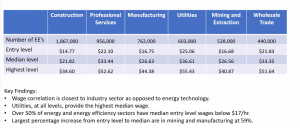 Stanton also said that, while retrofits can be daunting and time consuming, communities should not just look to new construction and technology for energy efficiency improvements “Existing housing stock is in pretty poor shape from an energy use standpoint, so we have to address that to really have a cleaner future.”
Stanton also said that, while retrofits can be daunting and time consuming, communities should not just look to new construction and technology for energy efficiency improvements “Existing housing stock is in pretty poor shape from an energy use standpoint, so we have to address that to really have a cleaner future.”
Jordan emphasized the effectiveness of apprenticeships to bridge the gap of understanding in the workforce, especially as training for many construction jobs can take two to five years. One out of every six construction jobs currently in the US are in energy efficiency, which underscores how important that sector is to all aspects of energy and life.
Dave Foster, the third speaker on the panel from Energy Futures Initiative, said that, in talking with people in the industry, “the President of United Steelworkers really captured the spirit of the 2019 USEER report. “We don’t have to choose between clean energy and jobs. We can and will have both.”
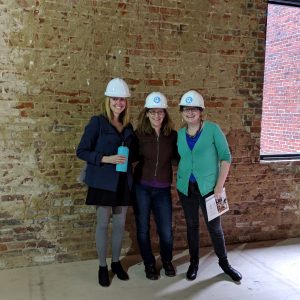 March is Women’s History Month, and to celebrate, we’re doing a Q&A spotlight on the three women behind the scenes here at the Virginia Energy Efficiency Council.
March is Women’s History Month, and to celebrate, we’re doing a Q&A spotlight on the three women behind the scenes here at the Virginia Energy Efficiency Council.
Chelsea Harnish is the Executive Director of VAEEC, which serves as the voice for the energy efficiency industry in the Commonwealth. Since 2015, Chelsea oversees all VAEEC operations and strategic initiatives, including programs, policy, communications, membership, and events. With over a decade of Virginia energy policy experience, Chelsea regularly engages with decision-makers, partners, and members to advance energy efficiency policies and programs that will help grow the industry throughout the Commonwealth. Prior to joining the VAEEC, Chelsea worked for several environmental nonprofits, honing her skills in campaign planning, communication and advocating for clean energy policy initiatives. Chelsea lives in Richmond with her husband, three-year old daughter, and two cats.
Jessica Greene joined VAEEC in September 2016 and serves as the Outreach Director. Jessica has diverse experience in the environmental field, including the areas of campaign planning, consulting, education, energy policy, organizing, and research. Prior to joining the VAEEC team, she devoted her time to campaigns and strategies focused on implementing clean, renewable energy at both the federal and state levels. Jessica lives in Richmond with her husband and their dog, Evie (and their soon-to-arrive twin boys, coming this summer!).
Rebecca Hui joined VAEEC as Administrative Assistant in October 2018. She brings her passions for writing and data analysis to the non-profit sphere to promote energy efficiency in Virginia. Prior to joining VAEEC, Rebecca honed her skills in a variety of roles, from agriculture to customer service to IT and communications, and feels committed to making a difference through the work she does. She lives in Richmond with her husband and two daughters.
Why are you passionate about EE?
JESSICA: Not only is energy efficiency a simple way to reduce pollution, conserve resources, and improve indoor air quality, but it also saves consumers money. Furthermore, it isn’t a solution only available to those of higher economic status; you don’t have to invest a lot of money to see improvements. There are plenty of no-cost, low-cost measures that can make a noticeable difference in your living environment and utility bills.
CHELSEA: Energy efficiency is the lowest-cost resource- the kilowatt saved is a penny earned. Energy efficiency doesn’t get as much attention as other forms of clean energy but it can make a big impact with little to no upfront costs. Since 2015, energy efficiency has been getting more notice from decision-makers, particularly with the passage of the Grid Transformation and Security Act of 2018. The opportunities to expand energy efficiency are boundless, so it is important that we make the most of it.
REBECCA: Coming from both the agriculture industry and IT, I’ve learned that the smallest changes can often make the biggest difference. Something as simple as thermal curtains or lightbulbs can reduce a family’s energy burden substantially, so it’s important to both the planet and its people that we share solutions that are attainable no matter where or how someone lives.
What brought you to the industry?
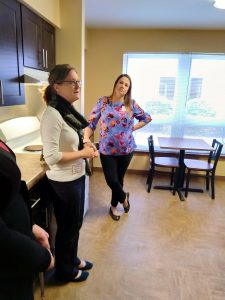 CHELSEA: I had been working on energy issues for over a decade when I joined VAEEC in 2015. My entire career has been spent in the nonprofit sector supporting a variety of clean energy technologies, including offshore wind and solar. I was excited to have the opportunity to lead an up and coming organization focusing on an industry that doesn’t get as much love as it should.
CHELSEA: I had been working on energy issues for over a decade when I joined VAEEC in 2015. My entire career has been spent in the nonprofit sector supporting a variety of clean energy technologies, including offshore wind and solar. I was excited to have the opportunity to lead an up and coming organization focusing on an industry that doesn’t get as much love as it should.
JESSICA: I majored in Environmental Science in college, which was really my first introduction to energy efficiency. However, it wasn’t until working on implementing the Clean Power Plan during a previous job that I realized the widespread, bipartisan benefits of energy efficiency.
REBECCA: It’s always been very important to me that the work that I do makes a quantifiable difference in the world around me, but joining VAEEC was really equal parts good timing and really good luck. Being able to learn about what energy efficiency really is and how it can help so many facets of people’s lives has been a huge opportunity for me, and the team is fantastic.
What are some of your hobbies?
CHELSEA: Right now, I don’t have very many hobbies because when I’m not leading my amazing team at VAEEC, I am chasing after my very active toddler at home. She has inherited my love for spending time outdoors, so you can usually find us outside at a local park or playground. I also enjoy running, reading, and traveling.
REBECCA: Like Chelsea, I don’t have a lot of time for hobbies as I have two daughters, ages 5 and 9, who constantly keep me on my toes. I am an avid baker thanks to my recent obsession with the Great British Baking Show, and I love reading, going to farmer’s markets, and travelling. We’re actually planning a family trip to Hong Kong in just a few months!
JESSICA: Traveling, concerts, and outdoor activities such as hiking, kayaking, and rock climbing are hands down my favorite hobbies. However, on a day-to-day basis, I enjoy walking my dog, Evie, through one of Richmond’s many parks alongside my husband or friends (and our soon-to-arrive twin boys, due this summer!)
What’s the weirdest job you’ve ever had?
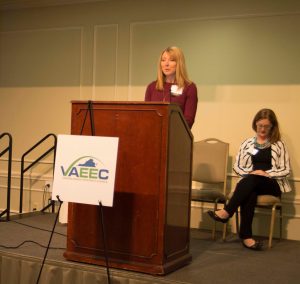 REBECCA: My very first job in high school was working for a frozen yogurt stand at the mall, where we also served smoothies. I frequently ended up with fruit in my hair or on the ceiling because the blender lids would bust off mid-blend!
REBECCA: My very first job in high school was working for a frozen yogurt stand at the mall, where we also served smoothies. I frequently ended up with fruit in my hair or on the ceiling because the blender lids would bust off mid-blend!
CHELSEA: I don’t consider this job weird but my most unique job was working in a full-scale public aquarium as an Aquarist right after college. It was my responsibility to feed all of the marine life, which included diving in a 55,000-gallon Pacific coral reef tank that was home to sharks, eels, and more.
JESSICA: I’ve held an assortment of jobs, but my most random one is probably being a residential and commercial painter for 10 years. It was a summer job I held from high school through graduate school.
What’s your favorite energy efficiency tip to share when people ask?
JESSICA: After moving into a 1940s house a few years ago, my number one tip is air sealing! You can start with small measures like using caulk and weather stripping to seal cracks. However, sealing our entire crawlspace made a noticeable difference in our house’s humidity levels. Our home is finally comfortable even in the middle of summer.
CHELSEA: I love my Nest Learning Thermostat! I like that it has learned our behaviors and that I can control it from my phone. Plus, collecting green leaves each month appeals to my competitive side.
REBECCA: Motion-sensitive light switches are amazing for my house. They save energy effortlessly and are much less expensive than smart home systems. Plus, no one has to say “turn off the lights!” every morning, which is a big win in my book.
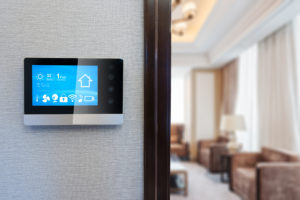 The Dominion DSM case was held Wednesday, March 20, 2019 before the three Commissioners of the State Corporation Commission (SCC). This was the first case being heard by the new Commissioner, Judge Patricia West. Our previous blog post on the DSM application went into detail about the programs themselves so this post will only focus on the proceeding. You can review all proceeding materials on the SCC webpage for this docket.
The Dominion DSM case was held Wednesday, March 20, 2019 before the three Commissioners of the State Corporation Commission (SCC). This was the first case being heard by the new Commissioner, Judge Patricia West. Our previous blog post on the DSM application went into detail about the programs themselves so this post will only focus on the proceeding. You can review all proceeding materials on the SCC webpage for this docket.
The proceeding was broken up into three main sections:
- Public Testimony
- Oral Arguments on Legal Memo
- DSM Proceeding
Oral Arguments
At the beginning of the proceeding, the Commissioners heard oral arguments on whether or not lost revenues should be considered as part of Dominion Energy’s commitment to propose $870M worth of energy efficiency programs over the next ten years, as part of the 2018 Grid Transformation and Security Act. Counsel for VAEEC reiterated the position, as stated in our legal brief, that lost revenues should not count towards the $870M, since the the statute that states this commitment does not mention lost revenues. Walmart, environmental respondents and the SCC staff agreed with our arguments. In addition, while the Attorney General’s office took no official position, they did mention in their oral arguments that no one- in either oral arguments or public comments (written and oral)- supported the Company’s position that lost revenues should be included in the commitment to propose $870M in energy efficiency programs over the next decade. The Commissioners asked a lot of questions during oral arguments and are anticipated to make a ruling on this issue in their Final Order for the DSM proceeding.
DSM Proceeding
During the proceeding, VAEEC, environmental respondents (Appalachian Voices and Natural Resources Defense Council), and Sierra Club supported all ten of the proposed EE programs (11 demand response programs in total). The SCC staff and the AG’s office were “unopposed” to seven programs and had “remaining concerns” about the other four.
During the hearing Dominion Energy staff stated that due to a calculation error regarding higher-than-expected participation rates for the Residential Engagement program, the Company had reduced their overall budget request to $203.9M.
VAEEC witness, Rachel Gold, with the American Council for an Energy-Efficient Economy, took the stand in support of the proposed programs and explained the value of benchmarking to evaluate whether or not the target set by the General Assembly- for Dominion Energy to propose $870 million in energy efficiency programming over the next decade- is achievable. The good news is, according to the results of that analysis done by ACEEE, this target should be easily attainable.
The seven programs with unanimous support were:
- Appliance Recycling Program
- Efficient Products Marketplace Program
- Smart Thermostat Management Program (DR)
- Smart Thermostat Management Program (EE)
- Non-Residential Window Film Program
- Non-Residential Lighting Systems & Controls Program
- Non-Residential Small Manufacturing Program
Initially, SCC staff stated that they were “unopposed” to the above programs. However, after further pressing by Commissioner Christie, SCC Staff stated that they did, in fact, support these programs. One interesting thing to note during this back and forth is that the Commissioners were expressing frustration with both Staff and the Company regarding the lack of analysis based on real energy savings. They argued that Staff should be able to take positions on proposed programs that are based on previously-approved programs since there would be real-energy savings data captured for those programs. While this data is provided by the Company in their annual EM&V filings, the Commission felt that the data could be provided in an more easy-to-digest format. Commissioner Christie directed the Company to produce a spreadsheet on previously approved programs to show the actual program costs and actual kWh savings. The Company asked for a one-week deadline to submit that table into evidence.
The inclusion of this type of table in future filings can bolster future applications by showing just how much savings are being realized by these programs, which could help win approval more easily. While the Commissioners are skeptical of energy efficiency programs and the projected savings they can achieve, that skepticism can potentially turn to support if strong energy-savings numbers are achieved in prior program iterations.
As mentioned above, SCC staff had concerns regarding the four remaining programs, which were:
- Home Energy Assessment Program: SCC staff was concerned that payout incentives were greater than material costs for individual products, which could lead to abuse. In rebuttal testimony, Dominion Energy pointed out that those assessments did not include labor costs.
- Customer Engagement Program: SCC staff were concerned about non-response rates and wanted the Company to provide traditional savings analysis for this program, which the Company did not do. An employee of the vendor took the stand to explain that behavioral programs cannot be analyzed in the way Staff was requesting, which was the reason the Company was unable to provide analysis. He then walked through how a behavioral program is assessed. According to our expert witness, Rachel Gold, who has worked for another leading company in this field, what he described is a standard practice used to evaluate these types of programs across the country.
- Non-Residential Heating and Cooling Efficiency Program: Staff’s concerns regarding this program were twofold; the TRC test score and participation rates. The Company rounded the TRC test score from 0.9965 to 1.00 in their application. Staff argued that 0.9965 was not “1” and therefore this program did not pass three of four cost tests as required by the statute. Judge Jagdman asked a clarifying question on the exact language of the statute indicating that she, at least, may be inclined to approve this program. Staff also stated they had concerns regarding the Company’s projected participation rates for the proposed program because the actual participation rates in the current program are far below the projected rates, and the new projected participation rates are even higher than the projected rates for the current program.
- Non-Residential Office Program: The issue with this program was related to the building size used in the modeling for the program. SCC staff stated that the Company was using office space of 100,000 sq. ft., which they were concerned was unrealistic and would therefore result in overstated cost-savings estimates. A Company witness from the vendor for this program testified that the program was modeled using 80,000 sq. ft. buildings, not 100,000 sq. ft., and that, 80,000sq. ft. was, in fact, a typical office building size in Dominion Energy’s service territory.
The Commission has until June 3rd to make their decision. We will be sure to let our members know the outcome once we have a chance to review the Final Order, so stay tuned for updates.
Future DSM Filings
During the hearing, VAEEC Board Member, Michael Hubbard, with Dominion Energy, announced that the Company had released their RFP for their next DSM filing the week before for 15 new programs. We have had a chance to review a summary of the RFP which includes some exciting new programs such as:
- Residential EE Retrofit
- Residential New Construction
- Home Energy Management System
- Residential Multi-Family EE Program
- Residential Manufactured Housing Program
- Residential EE Kits
- Residential Energy Advisor Program
- Residential Electric Vehicle Program
- Residential Enhanced Behavioral Program
- Non-Residential Behavioral Program
- Non-Residential Targeted-Sector Program
- Non-Residential Upstream and Midstream Efficient Products Incentives
- Non-Residential New Construction
- Non-Residential Strategic Energy Management
- Agricultural Energy Efficiency
We will continue to keep our members apprised of how these programs shape up for the next DSM filing in October 2019.
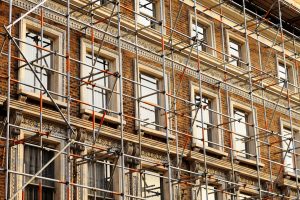 We are excited to announce that there has been a lot of C-PACE movement in Virginia over the past couple of months. The summary below provides an overview of the key highlights. Stay tuned for more information coming soon as C-PACE momentum is building across the Commonwealth.
We are excited to announce that there has been a lot of C-PACE movement in Virginia over the past couple of months. The summary below provides an overview of the key highlights. Stay tuned for more information coming soon as C-PACE momentum is building across the Commonwealth.
Attorney General Opinion
In response to a request from Loudoun County’s Attorney, the Virginia Office of the Attorney General issued an Advisory Opinion on the Commonwealth’s C-PACE law on February 1, 2019. The opinion clarifies two key issues: 1) local governments may authorize capital providers or third-party program administrators to perform billing and collecting of C-PACE loan payments, and 2) localities may assign rights to capital providers to record and enforce the voluntary special assessment liens that underlie C-PACE deals in the case of defaults. The full letter can be viewed here.
Loudoun County
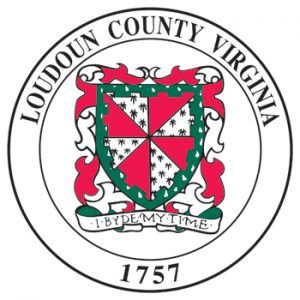 Since the release of the Attorney General’s Advisory Opinion, Loudoun County has been moving ahead at full force. The Board of Supervisors approved the County’s ordinance on February 21st. Now the County is in the procurement process for a third-party program administrator. The RFP is in development and is currently on schedule to be released later this month.
Since the release of the Attorney General’s Advisory Opinion, Loudoun County has been moving ahead at full force. The Board of Supervisors approved the County’s ordinance on February 21st. Now the County is in the procurement process for a third-party program administrator. The RFP is in development and is currently on schedule to be released later this month.
Fairfax County
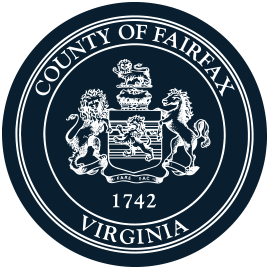 Back in January of this year, the VAEEC participated on the Fairfax County C-PACE Stakeholder Group to provide feedback on the County’s draft ordinance. Since the passage of SB 1559, the County plans to add resiliency measures to this ordinance, which is now scheduled to be considered by the Board of Supervisors on March 19th.
Back in January of this year, the VAEEC participated on the Fairfax County C-PACE Stakeholder Group to provide feedback on the County’s draft ordinance. Since the passage of SB 1559, the County plans to add resiliency measures to this ordinance, which is now scheduled to be considered by the Board of Supervisors on March 19th.
Hampton Roads
The Virginia Energy Efficiency Council partnered with the Hampton Roads Chamber of Commerce, the Mid-Atlantic PACE Alliance, Sustainable Real Estate Solutions (SRS), Viridiant, and the Virginia PACE Authority (VPA) to host a C-PACE workshop for the Hampton Roads region. This was one of our most attended C-PACE events to date, with over 50 people present. The room consisted of representatives from the Cities of Norfolk and Portsmouth, along with area developers, property owners, contractors, engineers, and architects.
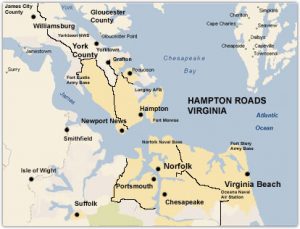
Speakers included Abby Johnson (VPA), City Councilmember Andria McClellan (Norfolk), Jessica Greene (VAEEC), Rob McRaney (Viridiant), and Scott Dicke (SRS). Topics covered included the value proposition of C-PACE for the Hampton Roads region, a history of C-PACE in Virginia, program administration basics, case studies, and action steps to bring C-PACE to the area. The full presentation can be viewed here.
Along with spreading the word about C-PACE, participants were encouraged to contact their local officials to urge the adoption of a C-PACE program. This includes contacting city councilmembers via phone, email, or by submitting letters of support. The VAEEC has created template letters of support that interested property owners, developers, or contractors can use to send to their local officials. Over the course of the past few years, the VAEEC has seen how constituent support and outreach plays a critical role in getting localities to move forward with developing a program.
If you would like to submit a letter to your local officials, the templates can be found below. Contact Jessica Greene (jessica@vaeec.org) with any questions.
2019 General Assembly: passage of two C-PACE bills
Senate Bill 1559 (Sen. Lynwood Lewis) was introduced to amend the current Commercial Property Assessed Clean Energy (C-PACE) statute to add “shoreline resiliency” to the list of projects that can be financed using C-PACE. VAEEC members Abby Johnson of the Virginia PACE Authority and Attorney Bill Nusbaum, along with Cliff Kellogg, drafted proposed amendments to expand the bill’s reach to cover all resiliency improvements as well as stormwater management measures. State staff also contributed language modifying the stormwater management reference by adding “with a preference for natural or nature-based features and living shorelines”. Further amendments also clarified the language around the need for a local government to specify a “maximum aggregate dollar amount” financeable under a C-PACE program in a local ordinance. In the amended version, a cap on total dollars allowed by a program would only be required if public funds were utilized. By contrast, if a C-PACE project were privately financed, then only a total project cap would be needed. The House approved the bill 99-0, and it was signed by the President of the Senate on February 22nd as SB1559ER.
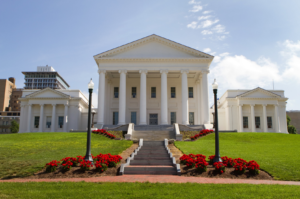 Senate Bill 1400 (Sen. J. Chapman Petersen) was introduced to add stormwater management to the list of projects that could be financed using C-PACE. Initially, this bill also authorized localities to establish Residential Property Assessed Clean Energy (R-PACE) financing; however, this language was stricken from the bill. By February 20th, the bill unanimously passed the House and the Senate to allow for C-PACE financing of stormwater management.
Senate Bill 1400 (Sen. J. Chapman Petersen) was introduced to add stormwater management to the list of projects that could be financed using C-PACE. Initially, this bill also authorized localities to establish Residential Property Assessed Clean Energy (R-PACE) financing; however, this language was stricken from the bill. By February 20th, the bill unanimously passed the House and the Senate to allow for C-PACE financing of stormwater management.
Both bills are now headed to the Governor’s desk for signature, and the new amendments will become effective on July 1, 2019. We hope that by making financing of resiliency and stormwater improvements available, more localities will adopt a C-PACE ordinance, thus making energy saving and renewable energy benefits of C-PACE more broadly available across Virginia.
We are excited to see such progress happening within these past few months and look forward to seeing more C-PACE programs come online across Virginia. For more information about C-PACE, check out our webpage, vaeec.org/PACE.
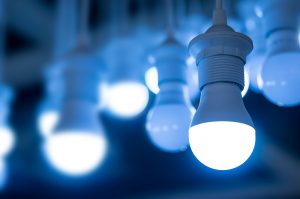 In October 2018, Dominion Energy proposed eleven new Demand-Response (DR) programs, ten of which are for energy efficiency, as part of their ten-year commitment to energy efficiency programs under the Grid Transformation and Security Act of 2018 (GTSA). The application totals $225.8 million of the $870 million committed under the GTSA, and includes six residential programs and five non-residential programs:
In October 2018, Dominion Energy proposed eleven new Demand-Response (DR) programs, ten of which are for energy efficiency, as part of their ten-year commitment to energy efficiency programs under the Grid Transformation and Security Act of 2018 (GTSA). The application totals $225.8 million of the $870 million committed under the GTSA, and includes six residential programs and five non-residential programs:
- Residential
- Appliance Recycling Program: would incentivize consumers to recycle eligible freezers and refrigerators.
- Home Energy Assessment Program: would facilitate a walk-through energy assessment and incentivize efficiency upgrades based on the findings.
- Smart Thermostat Management Program (DR): would provide consumers who already have an eligible smart thermostat an annual incentive to enroll in a peak demand response program.
- Smart Thermostat Management Program (EE): would provide a one-time rebate for customers who purchase an eligible smart thermostat.
- Efficient Products Marketplace Program: would establish a rebate program for qualified efficient products purchased through participating retailers or an online marketplace.
- Customer Engagement Program: would provide consumers with energy use data and energy saving suggestions.
- Non-residential
- Heating and Cooling Efficiency Program: would provide an incentive to qualifying customers to implement high efficiency heating and cooling technologies.
- Lighting Systems & Controls Program: would provide an incentive to qualifying customers to implement efficient lighting technologies with verifiable savings.
- Window Film Program: would incentivize customers to install solar reduction window film.
- Office Program: would offer incentives for installation of a variety of energy efficiency measures related to building systems to small office facilities.
- Small Manufacturing Program: would offer incentives for installation of a variety of energy efficiency measures to small manufacturing companies, primarily regarding compressed air systems.
If you are a VAEEC member, be sure to sign up for our webinar on March 5th for a deeper dive into the filing and a tutorial on how to prepare your own comments on these programs.
VAEEC has once again formally intervened in support of these programs in the proceeding before the State Corporation Commission (PUR-2018-00168) with Rachel Gold from the American Council for an Energy-Efficiency Economy (ACEEE) acting as our expert witness. We have again retained counsel from the UVA Environmental and Regulatory Law Clinic in support of the Company’s application.
In our pre-filed testimony, we provided strategies to improve the overall portfolio, provided analysis of the Company’s spending on EE programs as compared to other utilities in their peer group, and their progress towards spending $870M.
As part of our testimony, ACEEE performed a gap analysis to determine what other programs should be included in future DSM filings to reach $870M. This gap analysis identified five major program areas for future inclusion: Multi-Family, New Construction, Commercial & Industrial, Strategic Energy Management, and Midstream programs. These suggestions are listed in more detail on page 19 of our pre-filed testimony.
Our testimony includes additional analysis of Dominion’s spending on EE programs as compared to other utilities in their peer group, which is a group defined by the SCC. This group consists of six other southeastern utilities, including Duke Energy, APCo, and South Carolina Electric and Gas. According to that analysis, only the last two utilities listed spent less than Dominion on energy efficiency programs as a percentage of revenues in 2017, indicating that there is ample room for program expansion and a strong feasibility in meeting the $870M commitment.
Additionally, we do not support the Company’s inclusion of lost revenues in the $225M spending cap for energy efficiency programs since they are not costs associated with these specific programs. As stated in Ms. Gold’s testimony, “Lost revenue is not a cost of energy efficiency for the simple reason that these revenues still exist and are recovered by the utility from customers, even without any efficiency programs at all.” Including lost company revenues in the spending cap greatly reduces the amount of spending on actual energy-saving programs that benefit both the consumer and the companies that provide those services.
Finally, our pre-filed testimony also provided suggestions to maximize the effectiveness of the stakeholder process that was established under the GTSA last year. Building on the Stakeholder Framework VAEEC created last year in partnership with other groups like ACEEE, our testimony recommends setting clear objectives for the stakeholder group, focusing on three main areas: program design, evaluation, and policy. We also make recommendations based on the successful passage of SB 1605 and HB 2293, which will clarify the duration of the stakeholder process in addition to providing accountability measures for the group itself.
While our testimony has been filed, there is still ample time for non-intervenors to participate. The timeline below highlights some key dates, including due dates for written and oral public comments. We hope you will sign up for our webinar on March 5th to learn how to prepare your own comments for submission.
Timeline
February 15th: SCC Staff report due
March 5th: VAEEC members-only webinar, featuring Rachel Gold from ACEEE
March 13th: Written public comments due
March 20th: Proceeding before the SCC Commissioners, including public testimony
Late May/ Early June: SCC Final Order
Sign up today for our March 5th webinar!
If you are interested in researching further into this filing, you can use the search feature on the SCC website to read through public documents in the proceeding. Make sure to use the case number, PUR-2018-00168.
The Department of Energy plan to roll back federal energy efficiency light bulb standards will have wide-reaching consequences in Virginia and nationwide. ACEEE released this statement yesterday, positing that the decrease in regulatory standards would lead to an additional 80 billion kWh of energy usage per year, “about the combined usage of all households in Pennsylvania and New Jersey,” as well as pollution increases equal to, “the annual CO2 emissions of more than seven million cars.”
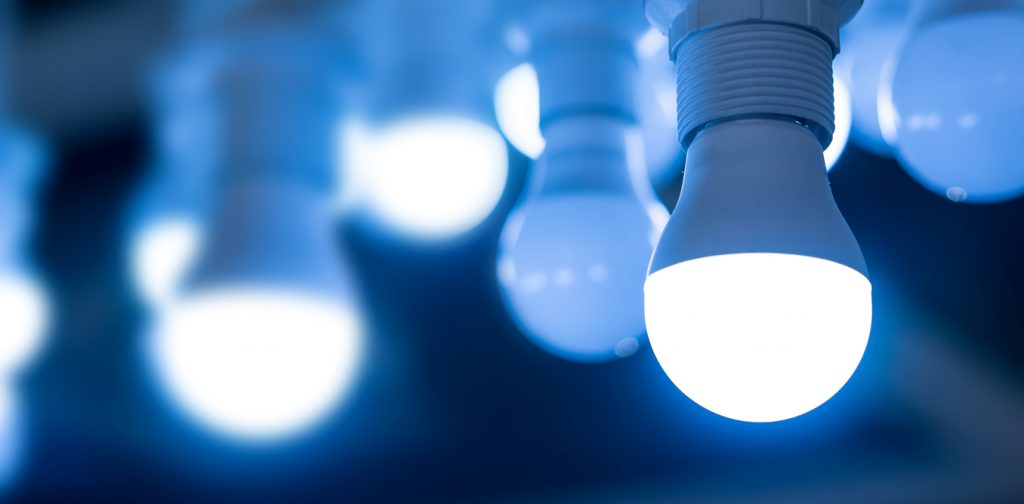
An estimated 115,000 jobs were predicted to come from Phase 2 of the Residential Lighting Program, with the average household saving roughly $100 dollars per year in energy costs.
Moreover, study after study has shown that low-income populations are consistently hit hardest by both energy costs and health effects. 8.5% of all Virginia residents suffer from asthma, with low income communities and young children affected at the highest rates. The environmental ramifications of deregulation will reverse the decreasing trend of asthma-related hospitalizations in the state.
Not only does this have negative consequences moving forward, but the standard that is now being rescinded was the basis of several SCC decisions to reduce energy efficiency program budgets in 2018. Appalachian Power was driven to withdraw one of the five proposed residential energy efficiency programs based on the SCC staff interpretation of the federal lighting standards. The SCC also reduced Dominion Energy’s low-income program from five to three years on the same basis. If implemented, these programs would have expanded LED installations, and other measures, across the state, saving money and conserving energy for the consumer.
As ACEEE stated, the draft rule “will almost assuredly draw legal challenges,” since the current roll back is most likely illegal, based on a federal law prohibiting the DOE from weakening energy efficiency programs on products like light bulbs.
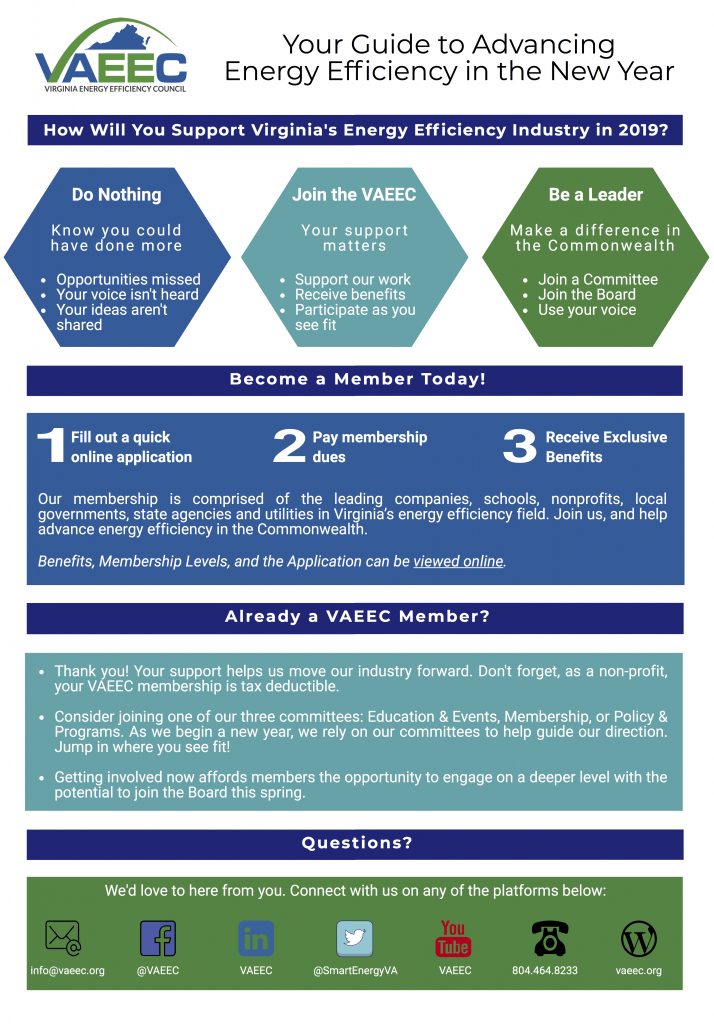 2019 has just started, which means it’s time to ring in those new year resolutions! What better way than to boost your support of energy efficiency. If you are not already a member of VAEEC, your first step is to join. It’s really quick and, as a member, you receive benefits like access to exclusive resources such as legislative updates, networking events, the membership directory, and our job-opening board. If you are already a member, you can use your voice and get involved with the Board or one of our three advisory committees. Help us move the Virginia Commonwealth even further with Energy Efficiency this year!
2019 has just started, which means it’s time to ring in those new year resolutions! What better way than to boost your support of energy efficiency. If you are not already a member of VAEEC, your first step is to join. It’s really quick and, as a member, you receive benefits like access to exclusive resources such as legislative updates, networking events, the membership directory, and our job-opening board. If you are already a member, you can use your voice and get involved with the Board or one of our three advisory committees. Help us move the Virginia Commonwealth even further with Energy Efficiency this year!
There’s no better time for making lifestyle changes and setting goals than the start of a new year. As 2019 approaches, we’re taking some of the most common resolutions and adding an energy-efficient twist. Not only will they help conserve energy, but they will also save you money for years to come.
 The typical weight loss resolution, although beneficial to health, can be a big consumer of energy during the winter months. The average treadmill uses between 600 and 700 watts of energy, and aging ones can consume 30 percent more energy than brand new machines. Instead, use Elliptical machines and stationary bikes, as they are generally self-powered or use six to seven times less energy than treadmills. Also, try to partake in outdoor workouts such as running, biking, or walking or performing at-home workouts without equipment when temperatures are extremely low.
The typical weight loss resolution, although beneficial to health, can be a big consumer of energy during the winter months. The average treadmill uses between 600 and 700 watts of energy, and aging ones can consume 30 percent more energy than brand new machines. Instead, use Elliptical machines and stationary bikes, as they are generally self-powered or use six to seven times less energy than treadmills. Also, try to partake in outdoor workouts such as running, biking, or walking or performing at-home workouts without equipment when temperatures are extremely low.
 Travel, while another popular resolution, is an expensive goal. Yet it can be made more affordable with a few simple steps. Before planning a trip, getting your car inspected and fixing any serious maintenance problems can improve your gas mileage by up to 40% and help you save more than $1,300 a year. If your destination is far away, consider taking a bus or a train instead of flying, as these modes of transportation are generally more energy-efficient and can be more affordable.
Travel, while another popular resolution, is an expensive goal. Yet it can be made more affordable with a few simple steps. Before planning a trip, getting your car inspected and fixing any serious maintenance problems can improve your gas mileage by up to 40% and help you save more than $1,300 a year. If your destination is far away, consider taking a bus or a train instead of flying, as these modes of transportation are generally more energy-efficient and can be more affordable.
 One resolution that should be on your list this year is to make energy-efficient improvements around your house or apartment. Energy-efficient upgrades improve your home’s comfort and value. Even better, they pay for themselves over time, and the addition of advanced technology, investments, and DIY projects could mean even more savings. To figure out what improvements will give you the best bang for your buck, consider getting your home inspected by a professional home energy auditor. Often they’ll do a blower door test and thermographic imaging to pinpoint exactly where energy is escaping. Several VAEEC members offer residential energy auditing services, such as the Fifth Fuel, Local Energy Alliance Program (LEAP), Think Little, and Viridiant.
One resolution that should be on your list this year is to make energy-efficient improvements around your house or apartment. Energy-efficient upgrades improve your home’s comfort and value. Even better, they pay for themselves over time, and the addition of advanced technology, investments, and DIY projects could mean even more savings. To figure out what improvements will give you the best bang for your buck, consider getting your home inspected by a professional home energy auditor. Often they’ll do a blower door test and thermographic imaging to pinpoint exactly where energy is escaping. Several VAEEC members offer residential energy auditing services, such as the Fifth Fuel, Local Energy Alliance Program (LEAP), Think Little, and Viridiant.
 Energy auditors provide suggestions on which upgrades would be most beneficial for your home. Suggestions could include sealing air leaks with caulk and weatherstripping, adding insulation throughout, and window treatments such as energy-saving storm panels, window shutters, or blinds. This can also include installing a programmable or wifi thermostat, such as the ones offered by VAEEC members Honeywell and Nest, to control household temperatures and scheduling. These improvements provide fast return on investment.
Energy auditors provide suggestions on which upgrades would be most beneficial for your home. Suggestions could include sealing air leaks with caulk and weatherstripping, adding insulation throughout, and window treatments such as energy-saving storm panels, window shutters, or blinds. This can also include installing a programmable or wifi thermostat, such as the ones offered by VAEEC members Honeywell and Nest, to control household temperatures and scheduling. These improvements provide fast return on investment.
You don’t have to take on your new year’s resolutions alone; they are easier and more effective when executed with others. Education and awareness are crucial components of successful energy efficiency practices. Serving as that liaison for family and friends will help them adopt such practices while also reinforcing your own actions and providing an opportunity to spend more time with one another. Monitoring progress together can be a fun activity or a competitive game. Resulting savings can even be put towards a fun outing.
As you can see, there are plenty of potential resolutions and goals, big and small, that can make a huge difference in your utility bills and wallets. Educate your loved ones, stay focused, and let’s make 2019 the most energy efficient year yet!

 As fall comes to a close and winter’s cold temperatures approach, it is essential to implement energy efficiency tips and technologies in your home to keep you and your family warm without the dreaded spike in your energy bills. There are many tips and tricks below that can be accomplished through simple, quick installations or practices.
As fall comes to a close and winter’s cold temperatures approach, it is essential to implement energy efficiency tips and technologies in your home to keep you and your family warm without the dreaded spike in your energy bills. There are many tips and tricks below that can be accomplished through simple, quick installations or practices.
Lower the thermostat to save up to 10% on utility bills.
While you may be tempted to increase the thermostat as it gets colder outdoors, lowering your thermostat by 7-10 degrees during colder months can save as much as 10 percent a year on utility bills.
Upgrade your technology.
Replacing your home’s older thermostat with a programmable one can lead to big savings by allowing you to manage energy usage when you’re not home. Other technologies, such as installing automatic timers, motion sensors, dimmers, and solar cells, are also great at conserving energy and are valuable tools that can be used year-round.
Use power strips, install light timers, take advantage of LED technology.
With the holiday season upon us, it’s even more important to be aware of energy consumption. From plugging in decorative lights to playing Christmas carols, a household can see a utility bill increase of $100 this time of year. To overcome this financial burden, consider using a power strip and/or install a light timer to control when the lights turn on and off. Another simple change is to invest in LED lighting. Not only do LED lights consume 70 percent less energy than conventional incandescent light strands, they also last much longer.
 Make smart choices in the kitchen.
Make smart choices in the kitchen.
Holiday baking and meal preparation can also increase your electricity and gas usage this time of year. Using the right-sized pots on stove burners can save about $36 annually for an electric range or $18 for gas. Also, using the oven light to check on dish’s progress instead of opening the door will prevent heat loss and wasted energy.
Turn down your water heater.
Did you know that water heating can account for 14 to 25 percent of the total energy used in a home? Reducing the preset water temperature and using cold water for laundry are easy ways to decrease those utility bills.
Maintain and check your home’s systems.
Another easy way to keep heat inside is to simply maintain and check your home’s systems. Proper maintenance of your HVAC system, including cleaning or replacement, can help keep those heating costs down. Giving that 30% of your home energy bill is a result of distribution losses when air moves from your furnace to the vents, changing or cleaning your filters regularly will help increase the efficiency while helping you clean up on your energy bills.
 With the proper precautions, anybody can enjoy a fun, warm holiday season without incurring the dreaded utility bill increases. These energy efficient life hacks are easy and can save a great deal of money, leaving room for you to treat yourself and your loved ones this holiday season.
With the proper precautions, anybody can enjoy a fun, warm holiday season without incurring the dreaded utility bill increases. These energy efficient life hacks are easy and can save a great deal of money, leaving room for you to treat yourself and your loved ones this holiday season.
 Stanton also said that, while retrofits can be daunting and time consuming, communities should not just look to new construction and technology for energy efficiency improvements “Existing housing stock is in pretty poor shape from an energy use standpoint, so we have to address that to really have a cleaner future.”
Stanton also said that, while retrofits can be daunting and time consuming, communities should not just look to new construction and technology for energy efficiency improvements “Existing housing stock is in pretty poor shape from an energy use standpoint, so we have to address that to really have a cleaner future.”



 The
The  We are excited to announce that there has been a lot of C-PACE movement in Virginia over the past couple of months. The summary below provides an overview of the key highlights. Stay tuned for more information coming soon as C-PACE momentum is building across the Commonwealth.
We are excited to announce that there has been a lot of C-PACE movement in Virginia over the past couple of months. The summary below provides an overview of the key highlights. Stay tuned for more information coming soon as C-PACE momentum is building across the Commonwealth. Since the release of the Attorney General’s Advisory Opinion, Loudoun County has been moving ahead at full force. The Board of Supervisors approved the County’s ordinance on February 21st. Now the County is in the procurement process for a third-party program administrator. The RFP is in development and is currently on schedule to be released later this month.
Since the release of the Attorney General’s Advisory Opinion, Loudoun County has been moving ahead at full force. The Board of Supervisors approved the County’s ordinance on February 21st. Now the County is in the procurement process for a third-party program administrator. The RFP is in development and is currently on schedule to be released later this month. Back in January of this year, the VAEEC participated on the Fairfax County C-PACE Stakeholder Group to provide feedback on the County’s draft ordinance. Since the passage of SB 1559, the County plans to add resiliency measures to this ordinance, which is now scheduled to be considered by the Board of Supervisors on March 19th.
Back in January of this year, the VAEEC participated on the Fairfax County C-PACE Stakeholder Group to provide feedback on the County’s draft ordinance. Since the passage of SB 1559, the County plans to add resiliency measures to this ordinance, which is now scheduled to be considered by the Board of Supervisors on March 19th.
 Senate Bill 1400 (Sen. J. Chapman Petersen) was introduced to add stormwater management to the list of projects that could be financed using C-PACE. Initially, this bill also authorized localities to establish Residential Property Assessed Clean Energy (R-PACE) financing; however, this language was stricken from the bill. By February 20th, the bill unanimously passed the House and the Senate to allow for C-PACE financing of stormwater management.
Senate Bill 1400 (Sen. J. Chapman Petersen) was introduced to add stormwater management to the list of projects that could be financed using C-PACE. Initially, this bill also authorized localities to establish Residential Property Assessed Clean Energy (R-PACE) financing; however, this language was stricken from the bill. By February 20th, the bill unanimously passed the House and the Senate to allow for C-PACE financing of stormwater management. In October 2018, Dominion Energy proposed eleven new Demand-Response (DR) programs, ten of which are for energy efficiency, as part of their ten-year commitment to energy efficiency programs under the
In October 2018, Dominion Energy proposed eleven new Demand-Response (DR) programs, ten of which are for energy efficiency, as part of their ten-year commitment to energy efficiency programs under the 

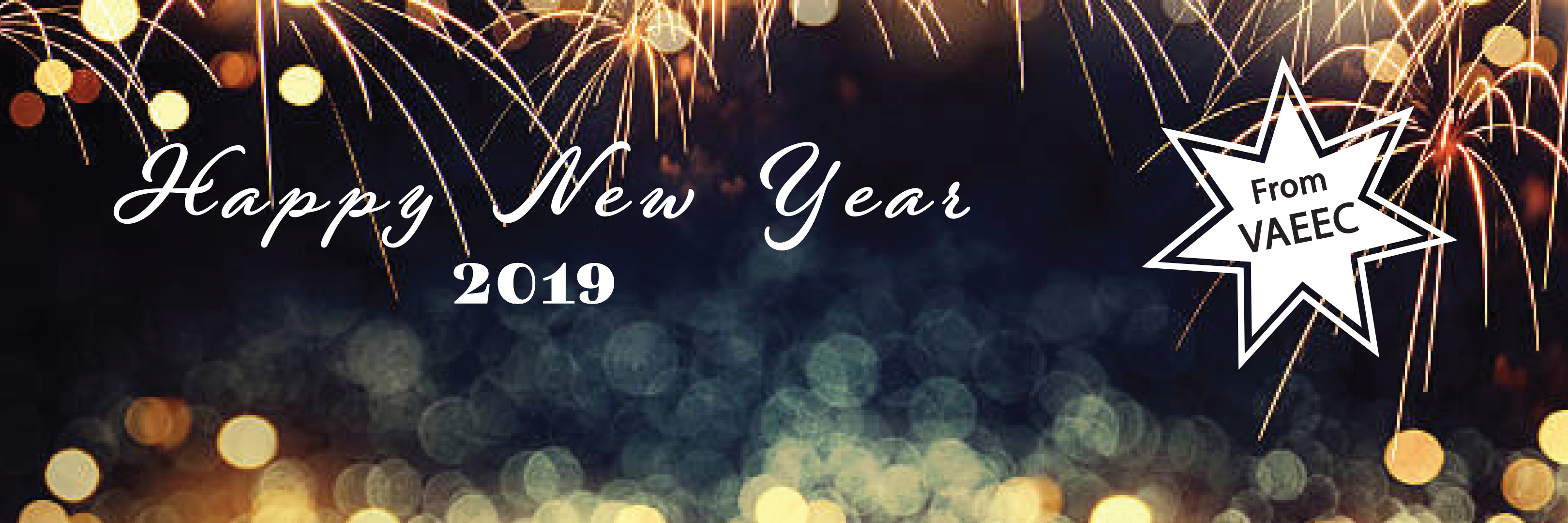
 The typical weight loss resolution, although beneficial to health, can be a big consumer of energy during the winter months. The average treadmill uses between 600 and 700 watts of energy, and aging ones can consume 30 percent more energy than brand new machines. Instead, use Elliptical machines and stationary bikes, as they are generally self-powered or use six to seven times less energy than treadmills. Also, try to partake in outdoor workouts such as running, biking, or walking or performing at-home workouts without equipment when temperatures are extremely low.
The typical weight loss resolution, although beneficial to health, can be a big consumer of energy during the winter months. The average treadmill uses between 600 and 700 watts of energy, and aging ones can consume 30 percent more energy than brand new machines. Instead, use Elliptical machines and stationary bikes, as they are generally self-powered or use six to seven times less energy than treadmills. Also, try to partake in outdoor workouts such as running, biking, or walking or performing at-home workouts without equipment when temperatures are extremely low.  Travel, while another popular resolution, is an expensive goal. Yet it can be made more affordable with a few simple steps. Before planning a trip, getting your car inspected and fixing any serious maintenance problems can improve your gas mileage by up to 40% and help you save more than $1,300 a year. If your destination is far away, consider taking a bus or a train instead of flying, as these modes of transportation are
Travel, while another popular resolution, is an expensive goal. Yet it can be made more affordable with a few simple steps. Before planning a trip, getting your car inspected and fixing any serious maintenance problems can improve your gas mileage by up to 40% and help you save more than $1,300 a year. If your destination is far away, consider taking a bus or a train instead of flying, as these modes of transportation are  One resolution that should be on your list this year is to make energy-efficient improvements around your house or apartment. Energy-efficient upgrades improve your home’s comfort and value. Even better, they pay for themselves over time, and the addition of advanced technology, investments, and DIY projects could mean even more savings. To figure out what improvements will give you the best bang for your buck, consider getting your home inspected by a professional home energy auditor. Often they’ll do a blower door test and thermographic imaging to pinpoint exactly where energy is escaping. Several VAEEC members offer residential energy auditing services, such as the
One resolution that should be on your list this year is to make energy-efficient improvements around your house or apartment. Energy-efficient upgrades improve your home’s comfort and value. Even better, they pay for themselves over time, and the addition of advanced technology, investments, and DIY projects could mean even more savings. To figure out what improvements will give you the best bang for your buck, consider getting your home inspected by a professional home energy auditor. Often they’ll do a blower door test and thermographic imaging to pinpoint exactly where energy is escaping. Several VAEEC members offer residential energy auditing services, such as the  Energy auditors provide suggestions on which upgrades would be most beneficial for your home. Suggestions could include sealing air leaks with caulk and weatherstripping, adding insulation throughout, and window treatments such as energy-saving storm panels, window shutters, or blinds. This can also include installing a programmable or wifi thermostat, such as the ones offered by VAEEC members
Energy auditors provide suggestions on which upgrades would be most beneficial for your home. Suggestions could include sealing air leaks with caulk and weatherstripping, adding insulation throughout, and window treatments such as energy-saving storm panels, window shutters, or blinds. This can also include installing a programmable or wifi thermostat, such as the ones offered by VAEEC members 
 As fall comes to a close and winter’s cold temperatures approach, it is essential to implement energy efficiency tips and technologies in your home to keep you and your family warm without the dreaded spike in your energy bills. There are many tips and tricks below that can be accomplished through simple, quick installations or practices.
As fall comes to a close and winter’s cold temperatures approach, it is essential to implement energy efficiency tips and technologies in your home to keep you and your family warm without the dreaded spike in your energy bills. There are many tips and tricks below that can be accomplished through simple, quick installations or practices.  Make smart choices in the kitchen.
Make smart choices in the kitchen. With the proper precautions, anybody can enjoy a fun, warm holiday season without incurring the dreaded utility bill increases. These energy efficient life hacks are easy and can save a great deal of money, leaving room for you to treat yourself and your loved ones this holiday season.
With the proper precautions, anybody can enjoy a fun, warm holiday season without incurring the dreaded utility bill increases. These energy efficient life hacks are easy and can save a great deal of money, leaving room for you to treat yourself and your loved ones this holiday season.